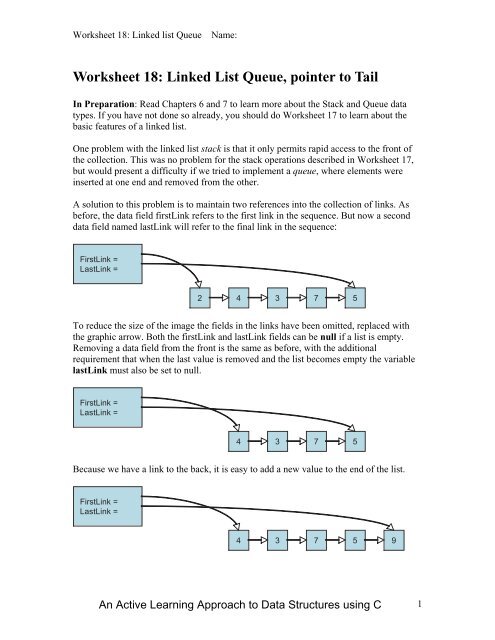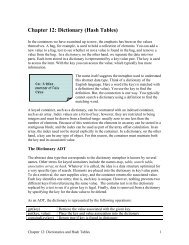Worksheet 18: Linked List Queue, pointer to Tail - Classes
Worksheet 18: Linked List Queue, pointer to Tail - Classes
Worksheet 18: Linked List Queue, pointer to Tail - Classes
Create successful ePaper yourself
Turn your PDF publications into a flip-book with our unique Google optimized e-Paper software.
<strong>Worksheet</strong> <strong>18</strong>: <strong>Linked</strong> list <strong>Queue</strong><br />
Name:<br />
<strong>Worksheet</strong> <strong>18</strong>: <strong>Linked</strong> <strong>List</strong> <strong>Queue</strong>, <strong>pointer</strong> <strong>to</strong> <strong>Tail</strong><br />
In Preparation: Read Chapters 6 and 7 <strong>to</strong> learn more about the Stack and <strong>Queue</strong> data<br />
types. If you have not done so already, you should do <strong>Worksheet</strong> 17 <strong>to</strong> learn about the<br />
basic features of a linked list.<br />
One problem with the linked list stack is that it only permits rapid access <strong>to</strong> the front of<br />
the collection. This was no problem for the stack operations described in <strong>Worksheet</strong> 17,<br />
but would present a difficulty if we tried <strong>to</strong> implement a queue, where elements were<br />
inserted at one end and removed from the other.<br />
A solution <strong>to</strong> this problem is <strong>to</strong> maintain two references in<strong>to</strong> the collection of links. As<br />
before, the data field firstLink refers <strong>to</strong> the first link in the sequence. But now a second<br />
data field named lastLink will refer <strong>to</strong> the final link in the sequence:<br />
FirstLink =<br />
LastLink =<br />
2 4 3 7 5<br />
To reduce the size of the image the fields in the links have been omitted, replaced with<br />
the graphic arrow. Both the firstLink and lastLink fields can be null if a list is empty.<br />
Removing a data field from the front is the same as before, with the additional<br />
requirement that when the last value is removed and the list becomes empty the variable<br />
lastLink must also be set <strong>to</strong> null.<br />
FirstLink =<br />
LastLink =<br />
4 3 7 5<br />
Because we have a link <strong>to</strong> the back, it is easy <strong>to</strong> add a new value <strong>to</strong> the end of the list.<br />
FirstLink =<br />
LastLink =<br />
4 3 7 5 9<br />
An Active Learning Approach <strong>to</strong> Data Structures using C 1
<strong>Worksheet</strong> <strong>18</strong>: <strong>Linked</strong> list <strong>Queue</strong><br />
Name:<br />
We will add another variation <strong>to</strong> our container. A sentinel is a special link, one that does<br />
not contain a value. The sentinel is used <strong>to</strong> mark either the beginning or end of a chain of<br />
links. In our case we will use a sentinel at the front. This is sometimes termed a list<br />
header. The presence of the sentinel makes it easier <strong>to</strong> address special cases. For<br />
example, the list of links is never actually empty, even when it is logically empty, since<br />
there is always at least one link. A new value is inserted after the end.<br />
Sentinel<br />
3 7 4 2<br />
Values are removed from the front, as with the stack. But because of the sentinel, the<br />
element removed will be the element right after the sentinel. Make sure that when you<br />
remove a value from the collection you free the memory for the associated link.<br />
You should complete the following skele<strong>to</strong>n code for the <strong>List</strong><strong>Queue</strong>. The structures have<br />
been written for you, as well as the initialization routine. The function isEmpty must<br />
determine whether or not the collection has any elements. What property characterizes an<br />
empty queue?<br />
On Your Own<br />
1. Draw a picture showing the values of the various data fields in an instance of<br />
<strong>List</strong><strong>Queue</strong> when it is first created.<br />
2. Draw a picture showing what it looks like after one element has been inserted.<br />
3. Based on the previous two drawings, can you determine what feature you can use <strong>to</strong><br />
tell if a list is empty?<br />
4. Draw a picture showing what it looks like after two elements have been inserted.<br />
5. What is the algorithmic complexity of each of the queue operations?<br />
6. How difficult would it be <strong>to</strong> write the method addFront(newValue) that inserts a<br />
new element in<strong>to</strong> the front of the collection? A container that supports adding<br />
values at either and, but removal from only one side, is sometimes termed a scroll.<br />
7. Explain why removing the value from the back would be difficult for this container.<br />
What would be the algorithmic complexity of the removeLast operation?<br />
An Active Learning Approach <strong>to</strong> Data Structures using C 2
<strong>Worksheet</strong> <strong>18</strong>: <strong>Linked</strong> list <strong>Queue</strong><br />
Name:<br />
struct link {<br />
TYPE value;<br />
struct link * next;<br />
};<br />
struct list<strong>Queue</strong> {<br />
struct link *firstLink;<br />
struct link *lastLink;<br />
};<br />
void list<strong>Queue</strong>Init (struct list<strong>Queue</strong> *q) {<br />
struct link *lnk = (struct link *) malloc(sizeof(struct link));<br />
assert(lnk != 0); /* lnk is the sentinel */<br />
lnk->next = 0;<br />
q->firstLink = q->lastLink = lnk;<br />
}<br />
void list<strong>Queue</strong>AddBack (struct list<strong>Queue</strong> *q, TYPE e) {<br />
}<br />
TYPE list<strong>Queue</strong>Front (struct list<strong>Queue</strong> *q) {<br />
}<br />
void list<strong>Queue</strong>RemoveFront (struct list<strong>Queue</strong> *q) {<br />
}<br />
int list<strong>Queue</strong>IsEmpty (struct list<strong>Queue</strong> *q) {<br />
}<br />
An Active Learning Approach <strong>to</strong> Data Structures using C 3

















